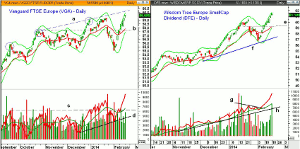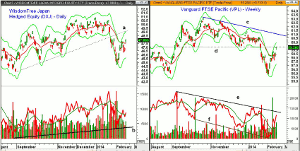Luckily, the emerging markets panic has not spread to more developed world markets, and MoneyShow’s Tom Aspray examines whether now would be a good time to establish positions in two of them.
The minor gains in all of the major averages on Tuesday were again accompanied by very strong market internals as twice as many stocks advanced as those that declined. The 1% loss in the Dow Transportation Average went largely unnoticed but may be an early warning of a market pullback.
After posting the best week in over two months, the US markets are overdue for a rest. The action in Asia was mixed, with Japan’s Nikkei closing lower while there were nice gains in both Hong Kong’s Hang Seng and the Shanghai Composite.
The European markets are mostly lower in early trading as the majority have also had impressive gains from the early February lows. The psychological impact of the sharp decline and then the equally sharp rally has made many frustrated with the markets.
Reacting to markets by either selling in fear or buying to avoid being left out is generally a bad idea as it often leaves both investors and traders either without a position or with a position that has too high a risk.
In the first week of February, I was recommending new positions in both the Eurozone and Japanese ETFs that I liked the best. Now that ETFs, like the Vanguard FTSE Europe ETF (VGK), have rallied over 8% from their February lows, and the Japan ETFs have also bounced, is it time to change your strategy?
Chart Analysis: The Vanguard FTSE Europe (VGK) is a low-cost way to participate in Europe’s growth. It has over 500 stocks with 20% in the top ten holdings. The United Kingdom makes up 32.9% with approximately 14% in France and Germany.
- VGK hit a low of $55.81on January 31 and reached a high, Tuesday, of $59.63.
- From the high to the low, this has been a gain of 6.8%.
- The daily starc- band is now being tested with the weekly at $61.01.
- Since September, VGK has tested the starc+ band three times (see circles) before correcting sharply.
- There is initial support now at $58.50 with the rising 20-day EMA at $57.86, line b.
- There is stronger chart support in the 56.60 area.
- The daily OBV broke out to the upside in early 2014 as it overcame the resistance at line c.
- The volume on the recent decline was quite heavy as the OBV dropped to better support.
- The OBV is now acting stronger than prices as it has made sharply higher highs.
- The weekly OBV has confirmed the new highs.
The Wisdom Tree Europe Small-Cap Dividend (DFE) has about 247 holdings with the highest level of concentration in the United Kingdom (25%), followed by Sweden (13.6%), and Italy (12.7%). It has a current yield of 2.39%.
- DFE has accelerated to the upside recently reaching a high of $61.47.
- This is a gain of 8.3% from the early February low of $56.76.
- The daily starc+ band has been tested with the weekly at $62.59.
- The volume has been very strong on the recent rally as the OBV has been very strong.
- The weekly OBV (not shown) is also confirming the price highs.
- There is first support at $60-$60.50 and then at $59.30 and the rising 20-day EMA.
- There is additional chart support in the $58 area.
NEXT PAGE: What About Japan?
|pagebreak|The extent of the slide in the Japanese market from the January highs took many investors out of their long positions but as I cautioned in early February, Don't Bail Out of Japan. The Japanese market has also rebounded nicely but not as much as Europe.
The WisdomTree Japan Hedged Equity (DXJ) has 312 stocks and hedges its yen exposure. It yields just over 1%.
- DXJ hit a low of $44.06 ten days ago and then closed Tuesday at $47.88, which is a gain of 8.7% from the lows.
- The quarterly pivot is at $48.99 with further resistance at $49.40, line a.
- The weekly starc+ band is at $51.37 with the quarterly projected pivot resistance at $54.53.
- Tuesday’s close was on the monthly pivot with minor support now at $47-$47.20.
- There is additional support at $46 and then at $45.50.
- The on-balance volume (OBV) did drop to stronger support, line b, in early February.
- The OBV is back above its WMA but the weekly OBV is not.
- So far, the volume on the rebound has not been impressive.
The Vanguard FTSE Pacific (VPL) has an expense ratio of 0.12% with 812 stocks. In addition to 56.4% of its holdings in Japan, it has 19.3% in Australia, 11.3% in Korea, 8.9% in Hong Kong, and 3.7% in Singapore. It has a yield of 2.66%.
- VPL was considerably weaker than DXJ on the market decline as it dropped 7.6% from its high of $60.40 in just ten days.
- On February 6, it triggered a high close doji buy signal.
- VPL has rallied to a high of $59.28, reaching the resistance at line d.
- There is much stronger resistance in the $60.75 with the quarterly pivot at $61.27.
- A doji was also formed Tuesday so the rally may be stalling.
- There is monthly pivot support now at $58.28 and then chart support at $57.45.
- The OBV is back above its WMA but did form lower lows in February, line f.
- The OBV needs to move through resistance at line e, to turn positive.
What It Means: The rally in Europe has been impressive, which makes a drop back to my original buy levels unlikely. Both Vanguard FTSE Europe (VGK) and Wisdom Tree Europe Small-Cap Dividend (DFE) do look ready for a pullback but I would not recommend buying at higher levels.
The rebound in the WisdomTree Japan Hedged Equity (DXJ) and in Vanguard FTSE Pacific (VPL) has been less impressive and a drop back to the February lows cannot be ruled out before a bottom is complete.
How to Profit: For the Vanguard FTSE Europe (VGK), go 50% long at $58.16 and 50% at $57.28, with stop at $55.87 (risk of approx. 3.2%).
For the Wisdom Tree Europe Small-Cap Dividend (DFE), go 50% long at $59.58 and 50% at $58.66, with stop at $57.44 (risk of approx. 2.8%).
For WisdomTree Japan Hedged Equity (DXJ), go 50% long at $45.06 and 50% long at $44.34, with a stop at $42.74 (risk of approx. 4%).
For Vanguard FTSE Pacific (VPL), go 50% long at $57.36 and 50% long at $56.44, with a stop at $55.48 (risk of approx. 2.5%).























